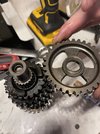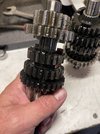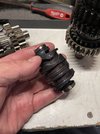Finished up assembling the F-150 rear axle last night. I prefer to heat the pinion bearings and slide them into place vs. beating on with a hammer. Bearings and impacts don't make good bed fellows. After heating the bearing to approx. 250-degrees it slides right on the outer pinion shaft, then add some oil to not only cool the bearing down to shrink it back onto the pinion but it also prelubes the bearing so it doesn't start dry.
This is where you need to be quick and avoid interruptions as there are a lot of moving pieces that need to take place in a certain order and the pinion bearing preload is a critical step.
I install the inner pinion bearing along with the final shim stack that was used to achieve the desired gear contact pattern. I add gear oil to the inner bearing and make sure it is thoroughly coated around the rollers. I then install the crush sleeve (or crush sleeve eliminator) and insert the pinion into the housing. I then have the seal at the ready by packing the back side with the spring with grease to avoid that spring coming out during installation. I also apply a small amount of sealant to the circumference of the seal and set it aside so it is ready along with the seal driver.
I also have my grunt tool (used to hold the pinion yoke) and my long 3/4" ratchet with proper socket for the pinion nut. This is where you need to work fluidly to ensure the outer pinion bearing goes onto the pinion as far as possible right up against the crush sleeve installed in the previous step, then apply gear oil to cool (shrink) and pre-lube the outer bearing. At this point install the pinion seal then the yoke with some Sil-glyde or lube applied to the seal surface and I prefer to use the old pinion nut for the initial preload setup. Install the grunt tool and begin crushing the crush sleeve. On new bearings I shoot for approx. 20-30 in/lbs. of rotating torque, used bearings I setup for approx. 8-15 in/lbs. Make sure you are not reading break-away torque and actually measuring rotating torque after the needle settles a bit. You have to be quick in reading this as you generally can't get more than about 180-degrees of rotation on the dial torque wrench due to interference with undercarriage and/or chassis components.
Once the pinion preload is set you can move back around to the rear and install the carrier. On this particular application we landed right at 25 in/lbs. of pinion preload.
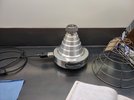
After the carrier is installed, carrier caps torqued to spec. (80 ft/lbs in this application), I then remove the case spreader and double check the backlash as well as confirm my total preload has increased slightly due to the carrier preload adding to the pinion preload. This ensure there is the proper preload from spreading the case and inserting the correct shim thickness.
In my opinion THIS is where a lot of gear setups go wrong. I don't want to offend anyone here but if you are not spreading the case to ensure you are getting the proper amount of carrier preload you are doing an injustice and the rear end will be living on borrowed time. Simply beating, hammering or prying the shims into place is not putting the correct carrier preload into the equation. What happens is now under heavy torque applications (racing, lifting a heavy vehicle up and over obstacles or just heavy throttle) is now pushing that carrier away from the pinion and therefore allowing the gears to climb up and away from the root of the gear towards toe face which is the thinner and weaker portion of the tooth. When you have the proper preload in the carrier this will not be allowed to happen and therefore keep the gears meshing in the same orientation as they were setup thus allowing for a long service life of the gears.
One last task that I do on all of my gears is just prior to buttoning up and putting the cover on is I engrave my specs on the outer diameter of the ring gear. I used to put my shop name but since I closed my business down, now I merely put my initials, date, pinion preload (PL), combined preload (CPL) and the backlash. I think I'm one of the few, if not the only one who does that because I've never opened up another rear axle and seen this before, even back when I was racing nor now when I see a lot of Jeeps that I know have been re-geared. I probably don't need to do this but I like to check things when I pull a cover and do something as simple as an oil change. If I pull someone's Jeep in for a differential service and it's one I've setup I like to throw the dial indicator on it and double check backlash if nothing more than to satisfy my own curiousity.
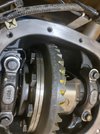
Freshly painted cover installed with a bead of RTV around the perimeter. I don't like putting gear oil in immediately and prefer to let them sit overnight for the RTV to cure before adding fluids and road testing. Probably overkill as the cover will need to come back off in 500-800 miles anyways for a service but I don't want it to leak in that time frame.
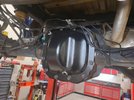
The last step in any job is to thoroughly clean and put tools away so they are ready for the next job. Plus I can't seem to sleep at night knowing I have tools that aren't in their proper home.

Tool cart gets rolled up right next to the toolbox and tools are wiped down and put away in their respective location.
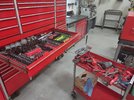
Also, things like wrenches, screwdrivers and pliers need to be facing the correct direction or there is a disturbance in the force and I can feel it.

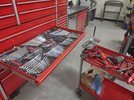
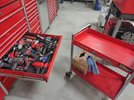
Very last thing after tool cart and benches are cleared is opening drawer by drawer to do a quick visual inspection and make sure I didn't leave a tool anywhere on the vehicle or out somewhere. My wife thinks I'm crazy but at a quick glance a person can see if something is missing or not in the correct spot.
Oh who am I kidding, my wife just thinks I'm crazy, period.
Thanks for looking.
Mike







